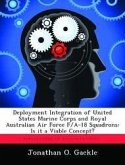This research project will show the evolution of the RAAF's doctrine, strategy, and force structure from the pre-WWII years to today's modern force. Specifically, this project will show how the lessons learned from the air battles in the Southwest Pacific Area of WWII have impacted today's RAAF. This project will begin by showing the transition of the RAAF from a British Empire dominion, early in WWII, to a force closely aligned with the United States during WWII. The main focus will be on the operational contributions the RAAF made to the Allied Southwest Pacific Area campaign in the Netherlands East Indies, New Guinea, and in Northern Australia. Finally, the project will show how the lessons from experiencing Japanese air superiority, early in WWII, influenced the doctrine, strategy, command organization and force structure of today's modern RAAF. This work has been selected by scholars as being culturally important, and is part of the knowledge base of civilization as we know it. This work was reproduced from the original artifact, and remains as true to the original work as possible. Therefore, you will see the original copyright references, library stamps (as most of these works have been housed in our most important libraries around the world), and other notations in the work. This work is in the public domain in the United States of America, and possibly other nations. Within the United States, you may freely copy and distribute this work, as no entity (individual or corporate) has a copyright on the body of the work. As a reproduction of a historical artifact, this work may contain missing or blurred pages, poor pictures, errant marks, etc. Scholars believe, and we concur, that this work is important enough to be preserved, reproduced, and made generally available to the public. We appreciate your support of the preservation process, and thank you for being an important part of keeping this knowledge alive and relevant.
Bitte wählen Sie Ihr Anliegen aus.
Rechnungen
Retourenschein anfordern
Bestellstatus
Storno









